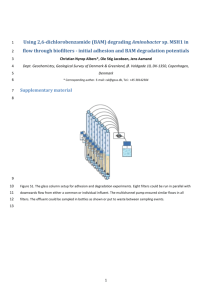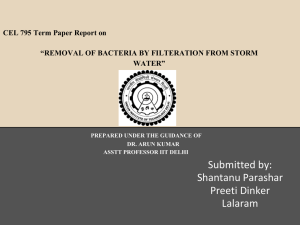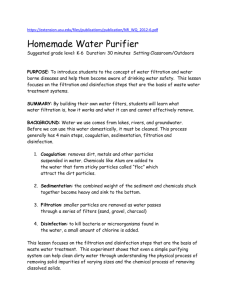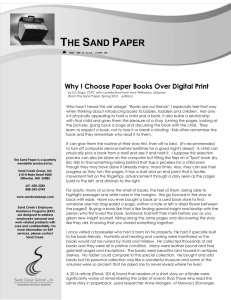Slow sand filtration_final - Controlled Environment Systems
advertisement
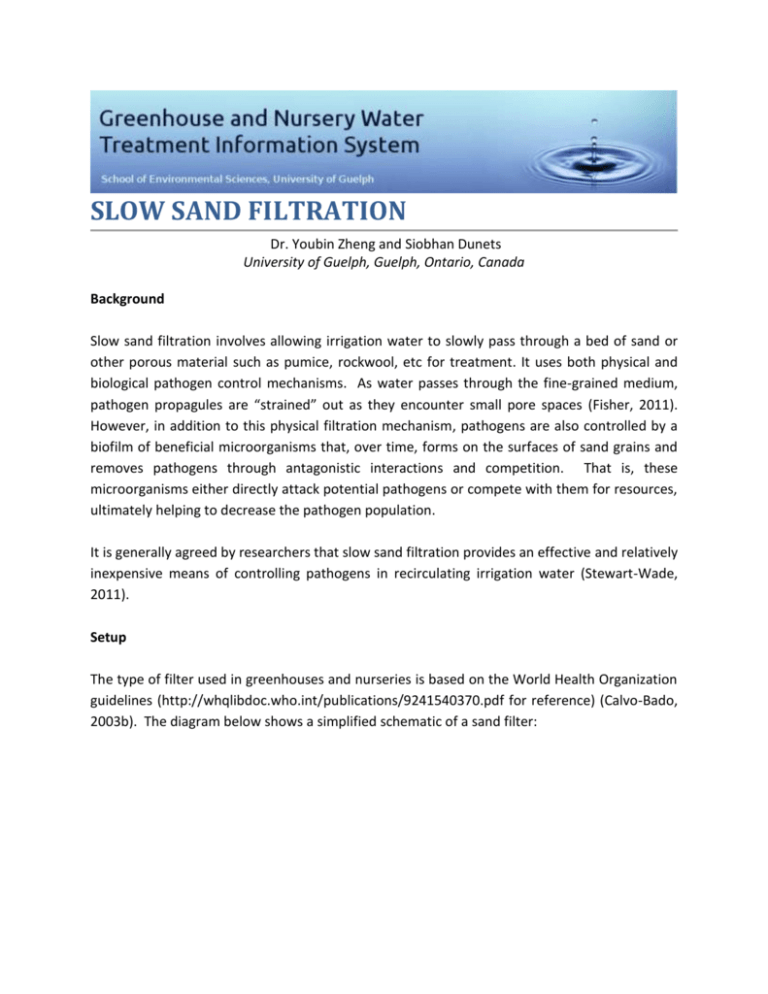
SLOW SAND FILTRATION Dr. Youbin Zheng and Siobhan Dunets University of Guelph, Guelph, Ontario, Canada Background Slow sand filtration involves allowing irrigation water to slowly pass through a bed of sand or other porous material such as pumice, rockwool, etc for treatment. It uses both physical and biological pathogen control mechanisms. As water passes through the fine-grained medium, pathogen propagules are “strained” out as they encounter small pore spaces (Fisher, 2011). However, in addition to this physical filtration mechanism, pathogens are also controlled by a biofilm of beneficial microorganisms that, over time, forms on the surfaces of sand grains and removes pathogens through antagonistic interactions and competition. That is, these microorganisms either directly attack potential pathogens or compete with them for resources, ultimately helping to decrease the pathogen population. It is generally agreed by researchers that slow sand filtration provides an effective and relatively inexpensive means of controlling pathogens in recirculating irrigation water (Stewart-Wade, 2011). Setup The type of filter used in greenhouses and nurseries is based on the World Health Organization guidelines (http://whqlibdoc.who.int/publications/9241540370.pdf for reference) (Calvo-Bado, 2003b). The diagram below shows a simplified schematic of a sand filter: The key components of a slow sand filter are as follows: Water layer: Provides hydraulic head (pressure) to push water through the sand filter below. In order to prevent the schmutzdeke from being exposed to temperature and moisture fluctuations, the water layer should be around 0.9m deep (Stewart-Wade, 2011). Schmutzdecke: This layer is a biofilm of microorganisms (as well as other organic and inorganic materials) that develops towards the surface of the sand bed over time, potentially to a depth of around 40 cm (Wohanka, 1995). The schmutzdecke is the main source of biological pathogen control in the sand filter. Antagonistic organisms that make up this layer include fungi, bacteria, nematodes, protozoa, and others (Stewart-Wade, 2011). Sand bed: The sand bed provides a medium for the schmutzdecke and the microorganism community in general to grow on, as well as providing physical filtration. Sand grain texture will affect porosity and ultimately biofilm creation. It is recommended sand grains be round to avoid packing and about 0.3mm in diameter to maximize surface area (Fisher, 2011). Media depth should be a minimum of 80cm (Stewart-Wade, 2011). Supporting gravel: This layer allows water to drain freely from the sand bed while preventing sand from escaping to the outlet tank (van Os, 1999). The layer may be around 0.15m and should be composed of gravel, or some other material that will allow free drainage. Gravel may range from fine (2-5mm) to coarse (7-15mm); either mixed together or in separate layers (van Os, 1999). Control valve: A system of control valves allows regulation of flow rate and adjustment of the depth of the water layer above the sand bed. Outlet tank: The outlet tank contains a weir that serves to prevent the water layer in the filter from dropping below the sand bed (maintains a minimum water depth in the filter). Ventilation of the outlet tank allows absorption of oxygen and release of other gases before filtered water flows to irrigation. Factors affecting filter performance Sand filters must be designed and installed specific to your operation. A number of factors must be taken into consideration in order to maximize filter effectiveness. Rate of water flow through the sand filter is possibly the main variable determining filter effectiveness. Flow rate should be slow to allow for proper filtration and allow a sufficient microbial community to develop and act on pathogens. Slower flow rates allow for adequate disease control even in the presence of high pathogen populations or small pathogen propagules (ex. of Fusarium). A flow rate of around 100 L/h/m2 maximizes performance (van Os, 2001). However, if disease presence appears to be less of an issue, a higher flow rate may be allowable. Flow rates of less than 300L/h/m2 can successfully remove Pythium and Phytopthora, and may be successfully implemented if disease pressure is not high (StewartWade, 2011). However, flow rates should not exceed 300L/h/m2, as no research has yet confirmed whether pathogens may be filtered out with water moving at this rate (StewartWade, 2011). Ultimately, deciding on the construction specifics of filter requires balancing the trade-off between improved filtration vs. slower flow rate. The slower the flow rate used, the larger (in surface area) the filter will need to be to filter a certain amount of water. Low flow rate will allow optimal pathogen filtration, however a very large filter may be required if large amounts of water must be treated per day. The size of filter can be decreased if the allowed flow rate is increased, but this may lead to less successful pathogen suppression. After determining your desired flow rate (based on which pathogens you need to control), you can determine the size of filter (square metres) you require based on how much water you want to treat. To determine the size of filter you require divide the amount of water your facility uses in an hour by your desired flow rate (in L/h/m2). The table below gives some examples of filter capacity (volume of water filtered/day) of different sized filters at various flow rates. SSF surface area 1 5 10 15 (m2) 100 (L/h) 2400L 12000L 24000L 36000L Flow rate 200 (L/h) 4800L 24000L 48000L 72000L 300 (L/h) 7200L 36000L 72000L 108000L In addition to flow rate, some other factors may play a role in determining filter efficacy. Increased organic matter content of the filter may serve to improve surface area available to adsorb microbes and decrease pore size, while also providing a food source for beneficial microorganisms to use (Furtner et al., 2007). Factors that affect the biological community of the filter also impact filtration effectiveness. Low temperatures will stunt microbial activity and as such decrease effectiveness (optimal activity at 10-20ºC) (Stewart-Wade, 2011). Oxygen deficiency may also decrease effectiveness. Most importantly, biological effectiveness depends on the microbial species and species diversity present in the microbial community of the filter. Research suggests certain specific species may be more beneficial to have present in filters than others (Calvo-Bado et al., 2003b). As such, filtration effectiveness could in theory be improved by directly inoculating these species into the filter rather than waiting for a natural community to develop. However, there is currently likely too little information available in this area to encourage any inoculation of this sort. Alternatively, it is also possible that just using the natural microflora that develops over time may maximize pathogen control (Stewart-Wade, 2011). The type of algae predominating in the schmutzdecke may also influence filtration. A predominance of filamentous algae will increase filtration rate, decrease resistance, and potentially hurt filtration performance (McNair et al., 1987). Effectiveness for pathogen removal Slow sand filters can be an effective means of controlling a wide variety of pathogen species. Unlike most other chemical and physical methods of pathogen control, slow sand filtration preserves the natural microorganism community surrounding the plant root. In recirculating systems, this community builds up and serves to suppress disease organisms. As such, information on how to sterilize water using sand filtration may be inappropriate as complete removal of a pathogen is likely not necessary to prevent disease incidence. The table below summarizes the effectiveness of slow sand filtration for controlling a variety of greenhouse pathogens. Generally, Phytopthora and Pythium species are fairly easily removed, while Fusarium and various nematodes and viruses can be removed at slower flow rates or only partially removed. Pathogen Fusarium oxysporum Propagule Conidia Phytopthora cryptogea Zoospores Phytopthora cinnamomi Zoospores Pythium aphanidermatum Zoospores Cylindrocladium Thielaviopsis Verticillium Xanthomonas campestris Spores Chlamydospores Microsclerotia Bacterium Radopholus similis Nematode Pelargonium Break Virus Flower Virus Filter Characteristics Flow rate: 300L/m2/h Depth: 0.4m Material: Rockwool granulate Flow rate: 150L/m2/h Depth: 1m Particle size: 0.3mm Flow rate: 100L/m2/h Depth: 0.8m Particle size: <0.5mm Flow rate: 300L/m2/h Depth: 0.4m Material: Rockwool granulate Not available Not available Not available Flow rate: 190L/m2/h Depth: 0.8m Particle size: 0-2mm Flow rate: 100L/m2/h Depth: 0.8m Particle size: <0.5mm Flow rate: 200L/m2/h Control status Eliminated (Bergstrand, 2011) Eliminated (CalvoBado, 2003b) Eliminated (van Os, 1999) Eliminated (Bergstrand, 2011) Eliminated (Ng, 1999) Eliminated (Ng, 1999) Eliminated (Ng, 1999) Eliminated (Brand and Wohanka, 2000) Partly eliminated (9099%) (van Os, 1999) Not eliminated, but infection delayed by 6 weeks and disease incidence reduced by 75% (Berkelmann et Tomato Mosaic Virus Virus Not available al., 1995) Partly eliminated (9099%) (van Os, 2001) Keep in mind that sand filter characteristics (grain size, porosity, etc.) vary between these studies. As such, an ideal standard for sand filter physical properties to maximize suppression of all potential pathogens cannot really be recommended. Ability of sand filters to control different pathogens will vary between filters based on numerous physical and biological characteristics. The above information provides an idea of the level of control that can be achieved with successful implementation of this technology. Maintenance The sand bed will have to be cleaned occasionally as the schmutzdecke will thicken over time and eventually impede water flow. To clean the filter, the sand bed will need to be drained to expose the top 2-3 inches of sand, and this layer is removed and replaced. Following this, the sand must be submerged and left for 24 hours to condition before it can be again used for treatment (Fisher, 2011). In combination with other technology Although the slow sand filter may act as a filter of particulate matter, pre-filtration is recommended. Otherwise, high particulate levels in the irrigation water can lead to frequent plugging of the small pores of the filter, which would require maintenance to be performed more frequently. Slow sand filtration could ultimately be incorporated along with the use of constructed wetlands to remove nutrients and provide further water treatment. This would present a promising water treatment method for operators looking to become certified organic. Cost for Technology The use of any water treatment technology is dependent on the size of the production facility and the amount of water used. Below are tables that summarize the average water consumption and Capital cost of the technology of a small, medium and large facility. Operating costs (not shown) are very low. Size of Production Facility Small Medium Large Size of Production Facility Small Medium Large Water Usage (litres/day) Greenhouse1 $29,263 – 37,857 $33,560 – 134,244 $117,057 – 151,431 Water Usage (litres/day) Nursery2 $700,993 – 2,103,001 $1,401,997 – 3,219,732 $1,609,854 - 4,829,610 Capital Cost Greenhouse3 $4,800 – 6,250 $5,500 – 22,200 $19,300 – 25,000 Capital Cost Nursery3,4 $278,000+ $556,000+ $638,000+ 1 Flowers Canada Growers. (2011). Website: http://flowerscanadagrowers.com Canadian Nursery Landscape Association. (2011). Website: www.canadanursery.com/ 3 Ranges have been estimated from a survey of companies and are only intended to give a rough idea of cost. To determine exact costs for your system, please contact a supplier. 4 Nurseries usually do not need to treat all their water, so nursery costs are likely overestimates. 2 This is cost of typical sand filter, excluding labour costs. Some specialized slow sand filtrationbased systems are available, which will tend to cost more (but with other advantages). Pros and Cons Pros: Relatively simple technology No potentially harmful chemicals used, so no risk to plants, workers, or environment Operating costs are very low Little technical monitoring required Cons: High installation cost Depending on the amount of water that must be filtered, the slow filter may take up a large amount of space and require a large amount of infrastructure The porosity of the filter is not uniform throughout. If large variability is present this may decrease filtration performance (Tu and Harwood, 2005) Efficacy breakdowns may occur occasionally. For example, a drop in pathogen propagule removal rate from 100% to 80-90% has been reported (Pettitt, 2002) Maintenance may need to be performed relatively frequently due to the potential for clogging Legionella bacteria have been found to make up a significant portion of the bacterial population in slow sand filters. Some species of Legionella are human pathogens (Calvo-Bado et al, 2003a). As such, it is recommended that the sand filter not be kept inside the greenhouse where high temperatures can lead to proliferation of Legionella (Calvo-Bado et al., 2003a). As well, levels of Legionella should be monitored to prevent harm to workers Summary Overall, slow sand filtration provides a reliable, relatively inexpensive means of controlling pathogens in greenhouse and nursery operations. This technology is particularly important for operators looking to decrease their impact on the environment or those looking to become certified organic. Unfortunately, because of the slow flow rates required for proper filtration, this technology may not be viable for large operations looking to disinfect irrigation water for a large area. While sand filters are relatively simple technology and can be constructed and installed by someone without expertise in the area, professionals should be consulted for advice as many factors can affect filter performance. Other materials such as rockwool and foam have also been tested for use in slow filters, and may prove promising in the future. Suppliers: Some examples of suppliers of slow sand filtration systems include: Producer Blue Future Filters Producer website http://www.bluefuturefilters.com/ References Bergstrand K., Khalil S., Hultberg M., and Alsanius B. W. 2011. Cross response of slow filters to dual pathogen inoculation in closed hydroponic growing systems. Open Horticulture Journal, 4: 1-9. Berkelmann B., Wohanka W., Krczal G. 1995. Transmission of Pelargonium Flower break virus (PFBV) by recirculating nutrient solutions with and without slow sand Filtration. Acta Horticulturae 382: 256–262. Calvo-Bado L.A., Morgan J.A.W., Sergeant M., Pettitt T.R., Whipps J.M. 2003a. Molecular characterization of Legionella populations present within slow sand W lters used for fungal plant pathogen suppression in horticultural crops. Applied Environmental Microbiology 69: 533–541. Calvo-Bado L.A., Pettitt T.R., Parsons N., Petch G.M., Morgan J.A.W., Whipps J.M. 2003b. Spatial and temporal analysis of the microbial community in slow sand Filters used for treating horticultural irrigation water. Applied Environmental Microbiology 69:2116– 2125. Fisher, P. 2011. Water Treatment: A grower’s guide for nursery and greenhouse irrigation. www.WaterEducationAlliance.org Furtner B., Bergstrand K.J., Brand T., Jung V., and Alsanius B.W. 2007. Abiotic and biotic factors in slow filters integrated to closed hydroponic systems. European Journal of Horticulture Science 72:104–112. Huisman, L. and Wood, W.E. 1974. Slow sand filtration. World Health Organization: Geneva. Website: http://whqlibdoc.who.int/publications/9241540370.pdf McNair D.R., Sims R.C., Sorensen D.L., and Hulbert M. 1987. Schmutzdecke characterization of clinoptilolite-amended slow sand filtration. American Water Works Association Journal 79: 74–81. Ng, K. 1999. Treatment of greenhouse recirculation water: biosand Filtration. Irrigation factsheet (July). Minstry of Agriculture, Food and Fisheries: British Columbia. Website: http://www.agf.gov.bc.ca/resmgmt/publist/500Series/512000-2.pdf Pettitt, T. 2002. Slow sand Filters for control of fungal plant pathogens. Good Fruit & Vegetables (August): 48. Stewart-Wade, S.M. 2011. Plant pathogens in recycled irrigation water in commercial plant nurseries and greenhouses: their detection and management. Irrigation Science 29: 267297. Tu J.C. and Harwood B. 2005. Disinfestation of recirculating nutrient solution by filtration as a means to control Pythium root rot of tomatoes. Acta Horticulturae 695: 303–307. van Os, E.A. 2001. Design of sustainable hydroponic systems in relation to environment-friendly disinfection methods. Acta Horticulturae 548: 197-205. van Os E.A., Amsing J.J., Van Kuik A.J., and Willers H. 1999. Slow sand Filtration: a potential method for the elimination of pathogens and nematodes in recirculating nutrient solutions from glasshouse-grown crops. Acta Horticulturae 481: 519–525



